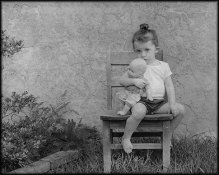I've got a few I like, but in general my 120 negatives don't look as nice as the 35mm ones. I'm assuming it's something with my exposure. I just processed a roll of Tri-X in D76 1:1. I think it was 9 min. 45 sec, if I remember correctly.
I've printed an image and it does have a lot of the same mid-tones, but the child has on a white t-shirt. They look gray to me. I've printed them a few different ways, once with more magenta for contrast than without. They still look blah.
The paper is old Kodak glossy. I've had some problems with some of the old paper I've got, but the borders are white as can be. Does that necessarily mean the paper's ok?
I should try printing another negative on the same paper and see what I get, I guess.
When I meter (using a Minolta IVF on ambient) I always give it another stop exposure. Should I give more than that? What could my problem be?
It's not just this paper. My 120 negatives look dull and flat to me.
Thanks!
Janet
I've printed an image and it does have a lot of the same mid-tones, but the child has on a white t-shirt. They look gray to me. I've printed them a few different ways, once with more magenta for contrast than without. They still look blah.
The paper is old Kodak glossy. I've had some problems with some of the old paper I've got, but the borders are white as can be. Does that necessarily mean the paper's ok?
I should try printing another negative on the same paper and see what I get, I guess.
When I meter (using a Minolta IVF on ambient) I always give it another stop exposure. Should I give more than that? What could my problem be?
It's not just this paper. My 120 negatives look dull and flat to me.
Thanks!
Janet



 No really, I do intend to order new paper soon.
No really, I do intend to order new paper soon.